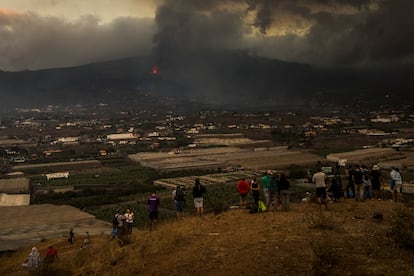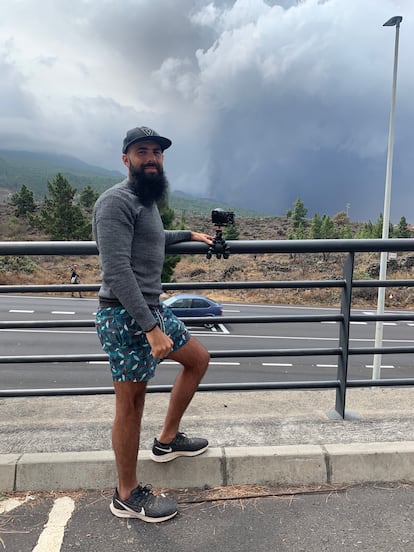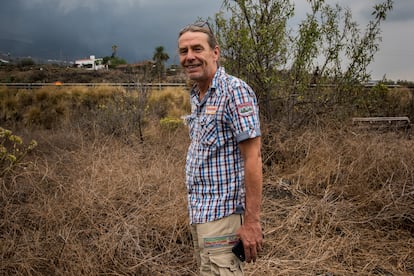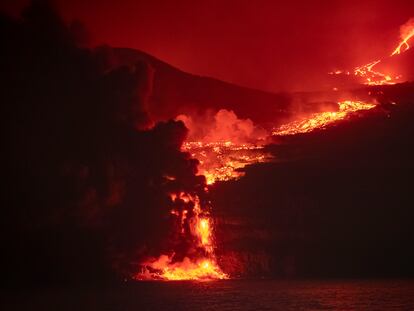‘Volcano tourists’ cause congestion on La Palma, with plane tickets going for as much as €500
The Civil Guard are unhappy with the number of onlookers and visitors that are flocking to catch a glimpse of the volcanic eruption. ‘Now is not the moment for tourism,’ says a representative of the hospitality sector


Andrés Amegeiras is from Uruguay. He’s aged 33 and has been traveling around the world for several months now. The last stage of his journey took him to the Canary Island of Fuerteventura . He was there on Sunday, when the Cabeza de Vaca volcano erupted. “Since it exploded I’ve been thinking about whether or not to come,” he explains. “In the end I decided on Wednesday.” He didn’t waver when he had to pay €500 for his plane ticket, which would usually not cost more than €60 under normal circumstances.
The awesome sights offered by the volcanic eruption have seen the Spanish island’s roads packed with traffic. Before the coronavirus pandemic, La Palma was a peaceful place, receiving barely 729,000 visitors during 2019, who stayed in the 17,000 beds offered by licensed tourist lodgings on offer. It’s a modest figure compared to the 8.4 million tourists received by Tenerife, one of the other Canary Islands, or the 6.5 million people who came to Gran Canaria, according to data from the Canarian Statistics Institute (ISTAC).
The volcanic eruption has seen La Palma put up the “no vacancy” sign. Curious onlookers and journalists have joined the tourists visiting the islands, and the planes and ships arriving are loaded with backpackers carrying camera equipment.
“Our associates in La Palma have said to us that a lot of tourists are arriving, mostly coming from other islands,” explains Juan Pablo González, the manager of Ashotel, a hospitality association serving the Canary Islands, which are a Spanish archipelago located in the Atlantic Ocean off the northwestern coast of Africa.
“They are coming with the simple aim of seeing the volcano,” he explains. “Now is not the moment for tourism for La Palma, it’s the time to help, and these people are not doing that and are instead occupying beds that could, for example, be used by the security forces.”

The pressure on the available accommodation on the island is making it difficult for residents who have been evacuated from their homes to find a place to stay, even for those who have the money to pay rent, Marta Cantero reports.
On Wednesday, a group of Civil Guard officers voiced their complaints to journalists who were about to get on a ship leaving Santa Cruz de Tenerife port, given that volcanologist tourists were able to get on board while they had been left without a ticket, Javier Salas reports.

One of these tourists is Mario Mesa, a 24-year-old biker from the nearby island of Tenerife who paid €60 for a boat ticket to La Palma. He just wanted to see the volcano. “I decided to do it on the spur of the moment,” he explains. “I work in a garden center, but I took a course on volcanology and geology so I didn’t hesitate.” He thought he would have a place to stay, but the volcanic eruption got in the way of that plan. “I have friends in Puerto Naos [which belongs to the municipality of Los Llanos de Aridane] who I was going to stay with, but they were evacuated on Tuesday,” he says. “I’ve now managed to get a place in a hostel.”
The traffic is heavy in the once-empty main roads on the island. Rental cars mix with those of the residents, with many of the latter loaded up with the personal effects they managed to save from their homes. There are regular snarl-ups in places where such a thing would have been unthinkable a week ago, such as the small area of Tajuya, in the municipality of El Paso, a preferred vantage point from which people can watch the eruption.

“We’ve had some problems with the traffic,” explains the Civil Guard officer in charge of controlling access to the devastated settlement of El Paraíso. “People are not aware of how dangerous this can be.”
The risks don’t appear to matter to Oliver and Susanne, a married couple from Berlin who arrived on the island on Tuesday night, and who spent the whole of Wednesday traveling by car to visit wherever they could enter in El Paso and Los Llanos de Aridane – the two municipalities worst-hit by the tongues of lava. “We will go wherever the police let us, we don’t want to cause any bother,” Oliver says.
Joan and Laia, two tourists from Barcelona, arrived on the island on Tuesday. “All of this is blowing my mind and saddens us,” they explain. They had their trip all planned out, but they have barely spent any time in their hotel in Puntagorda, in the north of the island. “What’s happening down here is much more interesting to us,” they admit. “We can’t miss out.”
English version by Simon Hunter.
Tu suscripción se está usando en otro dispositivo
¿Quieres añadir otro usuario a tu suscripción?
Si continúas leyendo en este dispositivo, no se podrá leer en el otro.
FlechaTu suscripción se está usando en otro dispositivo y solo puedes acceder a EL PAÍS desde un dispositivo a la vez.
Si quieres compartir tu cuenta, cambia tu suscripción a la modalidad Premium, así podrás añadir otro usuario. Cada uno accederá con su propia cuenta de email, lo que os permitirá personalizar vuestra experiencia en EL PAÍS.
¿Tienes una suscripción de empresa? Accede aquí para contratar más cuentas.
En el caso de no saber quién está usando tu cuenta, te recomendamos cambiar tu contraseña aquí.
Si decides continuar compartiendo tu cuenta, este mensaje se mostrará en tu dispositivo y en el de la otra persona que está usando tu cuenta de forma indefinida, afectando a tu experiencia de lectura. Puedes consultar aquí los términos y condiciones de la suscripción digital.
More information
Últimas noticias
Most viewed
- Reinhard Genzel, Nobel laureate in physics: ‘One-minute videos will never give you the truth’
- Oona Chaplin: ‘I told James Cameron that I was living in a treehouse and starting a permaculture project with a friend’
- Pablo Escobar’s hippos: A serious environmental problem, 40 years on
- Chevy Chase, the beloved comedian who was a monster off camera: ‘Not everyone hated him, just the people who’ve worked with him’
- Why we lost the habit of sleeping in two segments and how that changed our sense of time









































